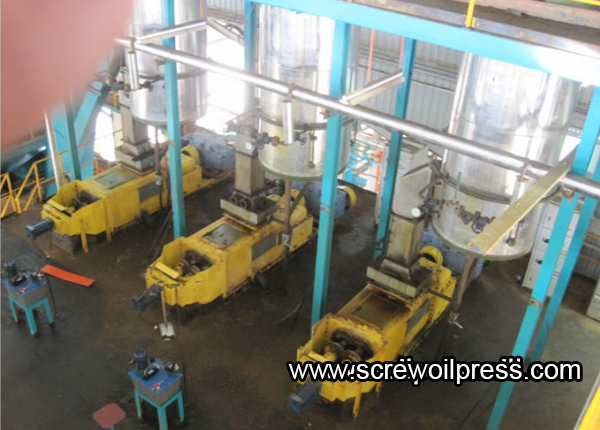- Oil Mill Machinery
- Oil Refinery Machinery
- Oil Processing Plant
- Solvent Extraction Plant
- Animal Oil Processing Machine
- Feed Processing Machine
- Palm Oil Mill
- Industrial Drying Machine
- Grain Processing Machinery

NEWS
Common Faults And Troubleshooting Methods Of Oil Press (2)
Time:Fri-11-21 hits:
We provide a complete set of engineering equipment for plant and animal oil processing, and a complete set of processing equipment such as cooking machines, presses, dryers, crushers, centrifuges, thickeners, evaporators, etc., adopting mature European technology, and provide solutions for construction, installation, commissioning and operation Training.

5. The oil press does not produce cakes
The cake is not fed smoothly, or the cake is not fed, and the cake is not fed: the oil press has the phenomenon of no feeding and no cake, mainly due to the improper use of the new machine when it is first used, (sometimes the hopper is blocked and the If the snails turn the leaves upside down so that no material is fed), the oil should be adjusted when the moisture content of the oil is inappropriate.
If it is not a moisture problem, the new machine should be operated in strict accordance with the instructions when using the new machine, and the feed should be controlled slowly, and the normal press can be entered when the standby temperature rises above 80 degrees.
And the new machine needs a running-in machine, generally 1-2 hours with cake and coarse sand running-in machine.
6. The oil of the oil press is blocked
(1) The belt is lubricated without material lifting. The main reason is that too much oil accumulates in the lower part of the conveyor of the bucket elevator, causing blockage. You can open the plate door at the lower part of the conveyor to remove the accumulated oil.
(2) The gear direction in the hopper is reversed.
When the new machine is shipped home, some customers need to install the motor by themselves, which requires the connection and installation of the motor and the machine.
Some customers may not pay attention and install the two in the opposite direction. At this time, the machine cannot operate normally and the oil is blocked.
(3) The sieve cloth oil material goes one side. During inspection, if the screen surface is not horizontally horizontal, the length of the left and right booms should be adjusted to make them equal;
If the screen body appears torsion, the eccentric wheel shaft can be adjusted to make it perpendicular to the frame. If the oil on the sieve surface is removed from the stone, the oil can be adjusted to make it level.
If the air flow is uneven, the air-regulating plate of the wind box can be adjusted to make the air flow evenly blow to the screen surface.
If the sieving rate is low, the brush should be replaced or the length of the brush should be adjusted, and the inclination angle of the flat screen should be adjusted at the same time.
(4) Uneven steaming of the upper pot. During the inspection, if the steam injection hole of the steamer is blocked or rusted, the steam injection hole should be cleared.
If the blank pastes the bottom of the pot in the middle and lower pot, the distance between the scraper and the bottom of the pot can be adjusted.
If the scraper is twisted and worn, the scraper should be replaced.
If the raw material is not evenly cooked, the limit switches, contacts and floating plates should be adjusted to coordinate their actions.
(5) The roll does not rotate when overloaded. The troubleshooting method is: if there is oil between the rolls when starting, loosen the roll adjustment bolts to remove the oil between the rolls.
If the feed rate is too large and the speed is too fast, the insert plate at the blanking opening can be closed; if the thickness of the rolled blank is uneven, the roll gap should be readjusted and the loose nut should be tightened.
7. The oil line of the oil press is blocked
The oil press can extract the clear oil from the top, and then accumulate the oil at the bottom of the barrel for natural precipitation. If there is a dedicated storage place, the extracted oil can be stored for a week (that is, natural precipitation). Then the clarity of the oil should be the best.
Use the fine gauze for the sieve surface to filter. If the amount is small, use a woven bag filled with flour. If the amount is large, you need to buy a filter pump for filtration, which can improve work efficiency.
The following methods can reduce precipitation:
(1) When there is too much feed in the initial stage of squeezing, the fried oilseed can be slowly fed in, and the mill can be used to remove it repeatedly.
(2) During the squeezing process, the material in the press chamber is cut off due to a large amount of material being fed and the press chamber is blocked by oil. Therefore, the feeding should be continuous and uniform. Once the blockage occurs, the power supply should be turned off immediately, the feeding should be stopped, the discharge plate should be opened, the screw shaft should be removed, the oil in the chamber should be removed, and the pressure should be re-squeezed.
(3) Because the peanuts, sesame and other crushed pieces are very small, the ordinary filters that are usually used cannot be completely removed. Therefore, most of the oil squeezed by the oil press has tiny crushed precipitates, but these crushed pieces will not bring health. Any harm will normally settle on the bottom of the bottle during the storage process, and it will not affect the consumption.









